Submitted:
30 June 2023
Posted:
03 July 2023
You are already at the latest version
Abstract
Keywords:
1. Introduction
2. Materials and Methods
2.1. Study area
2.2. Remote Sensing (LiDAR) data acquisition and processing
2.3. Topographic attributes
2.4. Field soil sampling and laboratory analysis
2.5. Hyperspectral spectroscopy measurements
2.6. Preliminary statistical data analysis and non-stationary geostatistical approach
2.6.1. Principal Component Analysis
2.6.2. Kriging with external drift
2.7. Mapping methods comparison
3. Results and discussion
3.1. Raster data
3.2. Coregionalization data set
3.3. Kriging with external drift
3.3.1. Trend estimation
3.3.2. Generalized Covariance Function (GCf) identification
3.4. Comparison among the three approaches
4. Conclusions
Author Contributions
Funding
Data Availability Statement
Conflicts of Interest
References
- Silvero, N.E.Q.; Demattê, J.A.M.; Minasny, B.; Rosin, N.A.; Nascimento, J.G.; Rodríguez Albarracín, H.S.; Bellinaso, H.; Gómez, A.M.R. Sensing Technologies for Characterizing and Monitoring Soil Functions: A Review. In; 2023; pp. 125–168.
- Ciampalini, R.; Follain, S.; Cheviron, B.; Le Bissonnais, Y.; Couturier, A.; Moussa, R.; Walter, C. Local Sensitivity Analysis of the LandSoil Erosion Model Applied to a Virtual Catchment. In Sensitivity Analysis in Earth Observation Modelling; Elsevier, 2017; pp. 55–73.
- McBratney, A.B.; Minasny, B.; Whelan, B. Defining Proximal Soil Sensing. In Proceedings of the The Second Global Workshop on Proximal Soil Sensing; Adamchuk, V.I., Viscarra Rossel, R.A., Eds.; McGill University: Montreal, 2011; pp. 144–146. [Google Scholar]
- Viscarra Rossel, R.A.; Adamchuk, V.I.; Sudduth, K.A.; McKenzie, N.J.; Lobsey, C. Proximal Soil Sensing. An Effective Approach for Soil Measurements in Space and Time. Advances in Agronomy 2011, 113, 237–282. [Google Scholar] [CrossRef]
- Mouazen, A.M.; Alexandridis, T.; Buddenbaum, H.; Cohen, Y.; Moshou, D.; Mulla, D.; Nawar, S.; Sudduth, K.A. Monitoring. In Agricultural Internet of Things and Decision Support for Precision Smart Farming; Castrignanò, A., Buttafuoco, G., Khosla, R., Mouazen, A., Moshou, D., Naud, O., Eds.; Elsevier: London, UK, 2020; pp. 35–138; ISBN 978-0-12-818373-1. [Google Scholar]
- Castrignanò, A.; Buttafuoco, G. Data Processing. In Agricultural Internet of Things and Decision Support for Precision Smart Farming; Castrignanò, A., Buttafuoco, G., Khosla, R., Mouazen, A., Moshou, D., Naud, O., Eds.; Elsevier Academic Press: London, UK, 2020; pp. 139–182; ISBN 9780128183731. [Google Scholar]
- Deutsch, C. V. A Review of Geostatistical Approaches to Data Fusion. In Geophysical Monograph Series; American Geophysical Union (AGU), 2007; Vol. 171, pp. 7–18 ISBN 9781118666463.
- Nguyen, H.; Cressie, N.; Braverman, A. Spatial Statistical Data Fusion for Remote Sensing Applications. J Am Stat Assoc 2012, 107, 1004–1018. [Google Scholar] [CrossRef]
- Pickett, S.; Kolasa, J.; Jones, C. Ecological Understanding. The Nature of Theory and the Theory of Nature; 2nd ed.; Academic Press: New York, 2010; ISBN 9780125545228. [Google Scholar]
- Carpenter, S.R.; Armbrust, E.V.; Arzberger, P.W.; Chapin, F.S.; Elser, J.J.; Hackett, E.J.; Ives, A.R.; Kareiva, P.M.; Leibold, M.A.; Lundberg, P.; et al. Accelerate Synthesis in Ecology and Environmental Sciences. Bioscience 2009, 59, 699–701. [Google Scholar] [CrossRef]
- Peters, D.P.C. Accessible Ecology: Synthesis of the Long, Deep, and Broad. Trends Ecol Evol 2010, 25, 592–601. [Google Scholar] [CrossRef] [PubMed]
- Prince, A.; Franssen, J.; Lapierre, J.-F.; Maranger, R. High-Resolution Broad-Scale Mapping of Soil Parent Material Using Object-Based Image Analysis (OBIA) of LiDAR Elevation Data. Catena (Amst) 2020, 188, 104422. [Google Scholar] [CrossRef]
- Banwart, S.A.; Bernasconi, S.M.; Blum, W.E.H.; de Souza, D.M.; Chabaux, F.; Duffy, C.; Kercheva, M.; Krám, P.; Lair, G.J.; Lundin, L.; et al. Chapter One - Soil Functions in Earth’s Critical Zone: Key Results and Conclusions. In Quantifying and Managing Soil Functions in Earth’s Critical Zone; Banwart, S.A., Sparks, D.L., Eds.; Advances in Agronomy; Academic Press, 2017; Vol. 142, pp. 1–27.
- Gillin, C.P.; Bailey, S.W.; McGuire, K.J.; Gannon, J.P. Mapping of Hydropedologic Spatial Patterns in a Steep Headwater Catchment. Soil Science Society of America Journal 2015, 79, 440–453. [Google Scholar] [CrossRef]
- Grebby, S.; Field, E.; Tansey, K. Evaluating the Use of an Object-Based Approach to Lithological Mapping in Vegetated Terrain. Remote Sens (Basel) 2016, 8, 843. [Google Scholar] [CrossRef]
- Räsänen, A.; Virtanen, T. Data and Resolution Requirements in Mapping Vegetation in Spatially Heterogeneous Landscapes. Remote Sens Environ 2019, 230, 111207. [Google Scholar] [CrossRef]
- Maesano, M.; Santopuoli, G.; Moresi, F.; Matteucci, G.; Lasserre, B.; Scarascia Mugnozza, G. Above Ground Biomass Estimation from UAV High Resolution RGB Images and LiDAR Data in a Pine Forest in Southern Italy. IForest 2022, 15, 451–457. [Google Scholar] [CrossRef]
- Soares, M.F.; Timm, L.C.; Siqueira, T.M.; dos Santos, R.C.V.; Reichardt, K. Assessing the Spatial Variability of Saturated Soil Hydraulic Conductivity at the Watershed Scale Using the Sequential Gaussian Co-Simulation Method. Catena (Amst) 2023, 221, 106756. [Google Scholar] [CrossRef]
- Brunori, E.; Maesano, M.; Moresi, F.V.; Matteucci, G.; Biasi, R.; Scarascia Mugnozza, G. The Hidden Land Conservation Benefits of Olive-based ( Olea Europaea L.) Landscapes: An Agroforestry Investigation in the Southern Mediterranean (Calabria Region, Italy). Land Degrad Dev 2020, 31, 801–815. [Google Scholar] [CrossRef]
- Mendonça, R.L.; Paz, A.R. da LiDAR Data for Topographical and River Drainage Characterization: Capabilities and Shortcomings. RBRH 2022, 27, e42. [Google Scholar]
- Alvites, C.; Santopuoli, G.; Maesano, M.; Chirici, G.; Moresi, F.V.; Tognetti, R.; Marchetti, M.; Lasserre, B. Unsupervised Algorithms to Detect Single Trees in a Mixed-Species and Multilayered Mediterranean Forest Using LiDAR Data. Canadian Journal of Forest Research 2021, 51, 1766–1780. [Google Scholar] [CrossRef]
- Santopuoli, G.; Di Febbraro, M.; Maesano, M.; Balsi, M.; Marchetti, M.; Lasserre, B. Machine Learning Algorithms to Predict Tree-Related Microhabitats Using Airborne Laser Scanning. Remote Sens (Basel) 2020, 12, 2142. [Google Scholar] [CrossRef]
- Maesano, M.; Khoury, S.; Nakhle, F.; Firrincieli, A.; Gay, A.; Tauro, F.; Harfouche, A. UAV-Based LiDAR for High-Throughput Determination of Plant Height and Above-Ground Biomass of the Bioenergy Grass Arundo Donax. Remote Sens (Basel) 2020, 12, 3464. [Google Scholar] [CrossRef]
- Debnath, S.; Paul, M.; Debnath, T. Applications of LiDAR in Agriculture and Future Research Directions. J Imaging 2023, 9, 57. [Google Scholar] [CrossRef]
- Tarolli, P. High-Resolution Topography for Understanding Earth Surface Processes: Opportunities and Challenges. Geomorphology 2014, 216, 295–312. [Google Scholar] [CrossRef]
- Leempoel, K.; Parisod, C.; Geiser, C.; Daprà, L.; Vittoz, P.; Joost, S. Very High-resolution Digital Elevation Models: Are Multi-scale Derived Variables Ecologically Relevant? Methods Ecol Evol 2015, 6, 1373–1383. [Google Scholar] [CrossRef]
- Curcio, A.C.; Peralta, G.; Aranda, M.; Barbero, L. Evaluating the Performance of High Spatial Resolution UAV-Photogrammetry and UAV-LiDAR for Salt Marshes: The Cádiz Bay Study Case. Remote Sens (Basel) 2022, 14, 3582. [Google Scholar] [CrossRef]
- Stenberg, B.; Viscarra Rossel, R.A.; Mouazen, A.M.; Wetterlind, J. Visible and Near Infrared Spectroscopy in Soil Science. In Advances in Agronomy; Academic Press, 2010; Vol. 107, pp. 163–215 ISBN 9780123810335.
- Viscarra Rossel, R.A.; Behrens, T.; Ben-Dor, E.; Brown, D.J.; Demattê, J.A.M.; Shepherd, K.D.; Shi, Z.; Stenberg, B.; Stevens, A.; Adamchuk, V.; et al. A Global Spectral Library to Characterize the World’s Soil. Earth Sci Rev 2016, 155, 198–230. [Google Scholar] [CrossRef]
- Riefolo, C.; Castrignanò, A.; Colombo, C.; Conforti, M.; Ruggieri, S.; Vitti, C.; Buttafuoco, G. Investigation of Soil Surface Organic and Inorganic Carbon Contents in a Low-Intensity Farming System Using Laboratory Visible and near-Infrared Spectroscopy. Arch Agron Soil Sci 2020, 66, 1436–1448. [Google Scholar] [CrossRef]
- Demattê, J.; Morgan, C.; Chabrillat, S.; Rizzo, R.; Franceschini, M.; da Silva Terra, F.; Vasques, G.; Wetterlind, J. Spectral Sensing from Ground to Space in Soil Science: State of the Art, Applications, Potential, and Perspectives. In Land Resources Monitoring, Modeling, and Mapping with Remote Sensing; Thenkabail, Ph.D., P.S., Eds.; CRC Press: Boca Raton, FL, 2015; pp. 661–732; ISBN 9780429089442. [Google Scholar]
- Minasny, B.; McBratney, Alex. B.B. Digital Soil Mapping: A Brief History and Some Lessons. Geoderma 2016, 264, 301–311. [Google Scholar] [CrossRef]
- Arrouays, D.; McBratney, A.; Bouma, J.; Libohova, Z.; Richer-de-Forges, A.C.; Morgan, C.L.S.; Roudier, P.; Poggio, L.; Mulder, V.L. Impressions of Digital Soil Maps: The Good, the Not so Good, and Making Them Ever Better. Geoderma Regional 2020, e00255. [Google Scholar] [CrossRef]
- Castrignanò, A.; Buttafuoco, G.; Quarto, R.; Parisi, D.; Viscarra Rossel, R.A.; Terribile, F.; Langella, G.; Venezia, A. A Geostatistical Sensor Data Fusion Approach for Delineating Homogeneous Management Zones in Precision Agriculture. Catena (Amst) 2018, 167, 293–304. [Google Scholar] [CrossRef]
- Chen, S.; Arrouays, D.; Leatitia Mulder, V.; Poggio, L.; Minasny, B.; Roudier, P.; Libohova, Z.; Lagacherie, P.; Shi, Z.; Hannam, J.; et al. Digital Mapping of GlobalSoilMap Soil Properties at a Broad Scale: A Review. Geoderma 2022, 409, 115567. [Google Scholar] [CrossRef]
- Burrough, P.A. Principles of Geographical Information Systems for Land Resources Assessment; Oxford University Press, 1986; ISBN 0198545630.
- 37. Wackernagel, Hans. Multivariate Geostatistics : An Introduction with Applications, Springer, 2003; ISBN 3540441425.
- Hudson, G.; Wackernagel, H. Mapping Temperature Using Kriging with External Drift: Theory and an Example from Scotland. International Journal of Climatology 1994, 14, 77–91. [Google Scholar] [CrossRef]
- Chilès, J.-P.; Delfiner, P. Geostatistics: Modeling Spatial Uncertainty, 2nd Edition; Wiley Series in Probability and Statistics; 2nd ed.; John Wiley & Sons; Inc.: Hoboken, NJ, USA, 2012; ISBN 9781118136188. [Google Scholar]
- Moresi, F.V.; Maesano, M.; Collalti, A.; Sidle, R.C.; Matteucci, G.; Scarascia Mugnozza, G. Mapping Landslide Prediction through a GIS-Based Model: A Case Study in a Catchment in Southern Italy. Geosciences (Basel) 2020, 10, 309. [Google Scholar] [CrossRef]
- Buttafuoco, G.; Castrignanò, A. Study of the Spatio-Temporal Variation of Soil Moisture under Forest Using Intrinsic Random Functions of Order k. Geoderma 2005, 128, 208–220. [Google Scholar] [CrossRef]
- Conforti, M.; Buttafuoco, G. Insights into the Effects of Study Area Size and Soil Sampling Density in the Prediction of Soil Organic Carbon by Vis-NIR Diffuse Reflectance Spectroscopy in Two Forest Areas. Land (Basel) 2023, 12, 44. [Google Scholar] [CrossRef]
- ARSSA Carta Dei Suoli Della Regione Calabria - Scala 1:250000. In Monografia Divulgativa; Servizio Agropedologia. Agenzia Regionale per Lo Sviluppo e per i Servizi in Agricoltura.; Soveria Mannelli, 2003.
- Soil Survey Staff Keys to Soil Taxonomy, 12th Ed. ; USDA-Natural Resources Conservation Service: Washington, DC, 2014.
- Olaya, V. A Gentle Introduction to SAGA GIS. The SAGA User Group eV, Gottingen, Germany 2004, 208. [Google Scholar]
- Sidari, M.; Ronzello, G.; Vecchio, G.; Muscolo, A. Influence of Slope Aspects on Soil Chemical and Biochemical Properties in a Pinus Laricio Forest Ecosystem of Aspromonte (Southern Italy). Eur J Soil Biol 2008, 44, 364–372. [Google Scholar] [CrossRef]
- Wilson, J.P.; Gallant, J.C. Terrain Analysis: Principles and Applications; John Wiley & Sons, Inc.: New York, NY, 2000; ISBN 978-0-471-32188-0. [Google Scholar]
- Conforti, M.; Longobucco, T.; Scarciglia, F.; Niceforo, G.; Matteucci, G.; Buttafuoco, G. Interplay between Soil Formation and Geomorphic Processes along a Soil Catena in a Mediterranean Mountain Landscape: An Integrated Pedological and Geophysical Approach. Environ Earth Sci 2020, 79, 59. [Google Scholar] [CrossRef]
- Conforti, M.; Lucà, F.; Scarciglia, F.; Matteucci, G.; Buttafuoco, G. Soil Carbon Stock in Relation to Soil Properties and Landscape Position in a Forest Ecosystem of Southern Italy (Calabria Region). Catena (Amst) 2016, 144, 23–33. [Google Scholar] [CrossRef]
- Renard, K.G.; Foster, G.R.; Weesies, G.A.; McCool, D.K.; Yoder, D.C. Predicting Soil Erosion by Water: A Guide to Conservation Planning with the Revised Universal Soil Loss Equation (RUSLE). Agriculture Handbook No. 703; US Department of Agriculture: Washington, DC, 1997; ISBN 0160489385. [Google Scholar]
- Moore, I.D.; Gessler, P.E.; Nielsen, G.A.; Peterson, G.A. Soil Attribute Prediction Using Terrain Analysis. Soil Science Society of America Journal 1993, 57, 443–452. [Google Scholar] [CrossRef]
- Sequi, P.; De Nobili, M. Determinazione Del Carbonio Organico. In Metodi di analisi chimica del suolo; Violante, P., Ed.; Franco Angeli: Roma, 2000; pp. 18–25. [Google Scholar]
- Soil Science Division Staff Soil Survey Manual. USDA Handbook 18; Ditzler, C., Scheffe, K., Monger, H.C., Eds.; Government Printing Office: Washington, D. C, 2017. [Google Scholar]
- Rock, B.N.; Williams, D.L.; Moss, D.M.; Lauten, G.N.; Kim, M. High-Spectral Resolution Field and Laboratory Optical Reflectance Measurements of Red Spruce and Eastern Hemlock Needles and Branches. Remote Sens Environ 1994, 47, 176–189. [Google Scholar] [CrossRef]
- Shepherd, K.D.; Walsh, M.G. Development of Reflectance Spectral Libraries for Characterization of Soil Properties. Soil Science Society of America Journal 2002, 66, 988. [Google Scholar] [CrossRef]
- Castrignanò, A.; Quarto, R.; Venezia, A.; Buttafuoco, G. A Comparison between Mixed Support Kriging and Block Cokriging for Modelling and Combining Spatial Data with Different Support. Precis Agric 2019, 20, 1–21. [Google Scholar] [CrossRef]
- Webster, R.; Oliver, M.A. Geostatistics for Environmental Scientists; Statistics in Practice; John Wiley & Sons, Ltd: Chichester, UK, 2007; ISBN 9780470517277. [Google Scholar]
- Jackson, J.E. User’s Guide to Principal Components; John Wiley & Sons: New York, 2003; ISBN 978-0-471-47134-9. [Google Scholar]
- Cattell, R.B. The Scientific Use of Factor Analysis in Behavioral and Life Sciences; Springer US: Boston, MA, 1978; ISBN 978-1-4684-2264-1. [Google Scholar]
- Yong, A.G.; Pearce, S. A Beginner’s Guide to Factor Analysis: Focusing on Exploratory Factor Analysis. Tutor Quant Methods Psychol 2013, 9, 79–94. [Google Scholar] [CrossRef]
- SAS SAS/STAT Software 2020.
- Matheron, G. The Intrinsic Random Functions and Their Applications. Adv Appl Probab 1973, 5, 439–468. [Google Scholar] [CrossRef]
- Vessia, G.; Di Curzio, D.; Castrignanò, A. Modeling 3D Soil Lithotypes Variability through Geostatistical Data Fusion of CPT Parameters. Science of The Total Environment 2020, 698, 134340. [Google Scholar] [CrossRef]
- Carroll, S.S.; Cressie, N. A Comparison of Geostatistical Methodologies Used To Estimate Snow Water Equivalent. J Am Water Resour Assoc 1996, 32, 267–278. [Google Scholar] [CrossRef]
- Heege, H.J. Sensing of Natural Soil Properties. In Precision in Crop Farming: Site Specific Concepts and Sensing Methods: Applications and Results; Heege, H.J., Ed.; Springer Netherlands: Dordrecht, 2013; pp. 51–102; ISBN 978-94-007-6760-7. [Google Scholar]
- Riefolo, C.; Belmonte, A.; Quarto, R.; Quarto, F.; Ruggieri, S.; Castrignanò, A. Potential of GPR Data Fusion with Hyperspectral Data for Precision Agriculture of the Future. Comput Electron Agric 2022, 199, 107109. [Google Scholar] [CrossRef]
- Telles, E. de C.C.; de Camargo, P.B.; Martinelli, L.A.; Trumbore, S.E.; da Costa, E.S.; Santos, J.; Higuchi, N.; Oliveira, R.C. Influence of Soil Texture on Carbon Dynamics and Storage Potential in Tropical Forest Soils of Amazonia. Global Biogeochem Cycles 2003, 17. [Google Scholar] [CrossRef]
- Lucà, F.; Robustelli, G.; Conforti, M.; Fabbricatore, D. Geomorphological Map of the Crotone Province (Calabria, South Italy). J Maps 2011, 7, 375–390. [Google Scholar] [CrossRef]
- Conforti, M.; Filomena, L.; Muto, F. Integrating Geological, Geomorphological and GIS Analysis to Evaluate the Spatial Distribution of Landslides in the Cino Stream Catchment (Calabria, South Italy). Rendiconti Online Società Geologica Italiana 2012, 21, 387–389. [Google Scholar]
- Wadoux, A.M.J.C.; Román-Dobarco, M.; McBratney, A.B. Perspectives on Data-Driven Soil Research. Eur J Soil Sci 2020, 72, 1675–1689. [Google Scholar] [CrossRef]


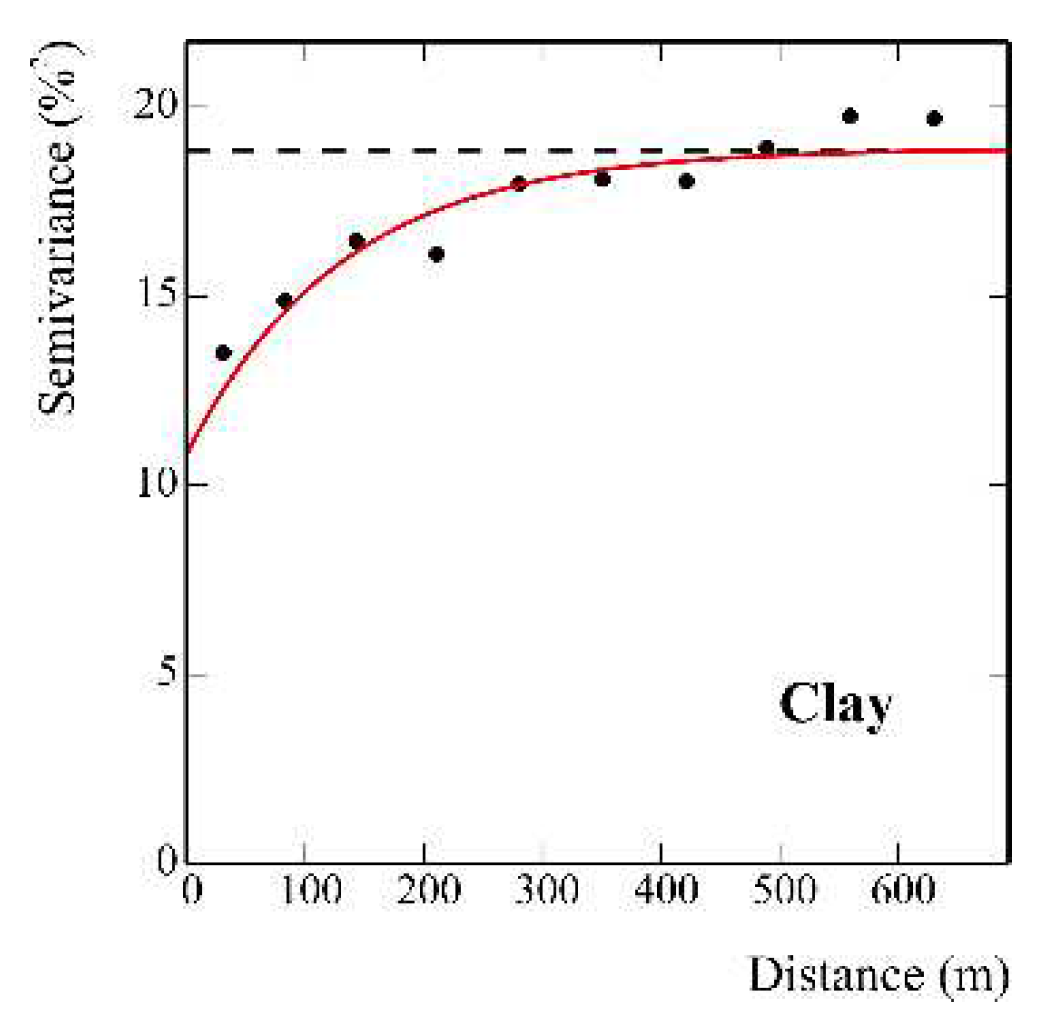
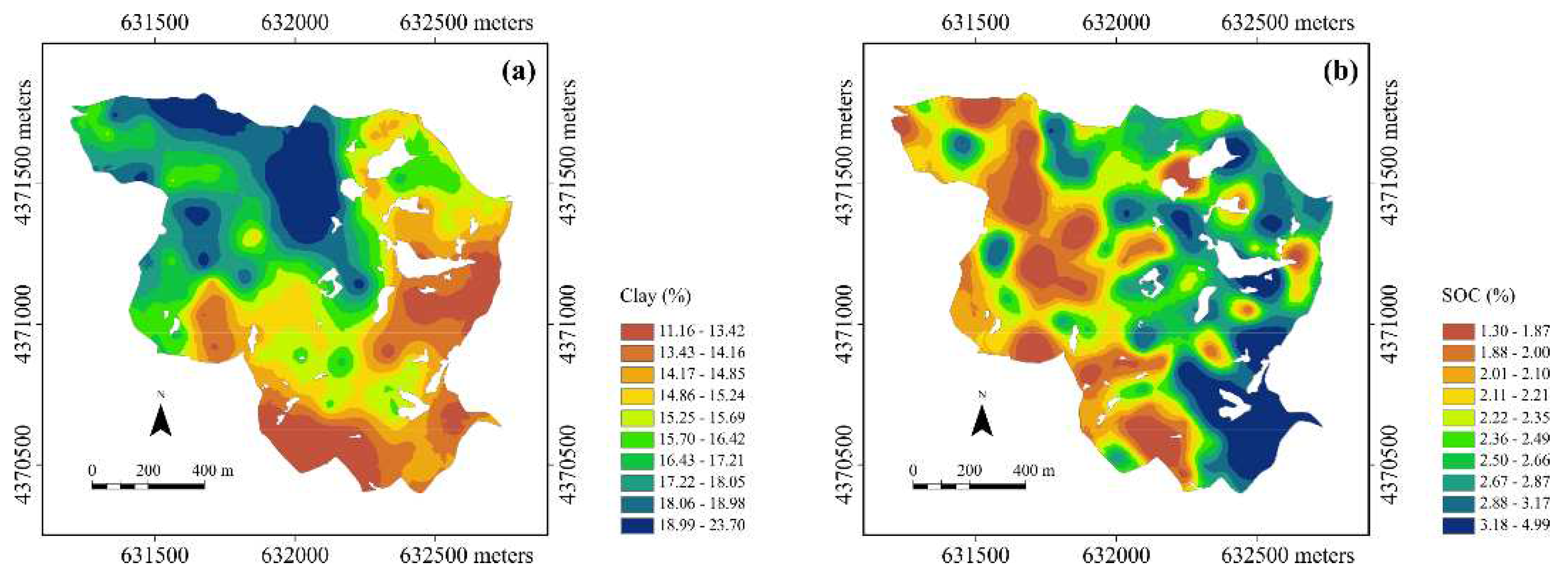
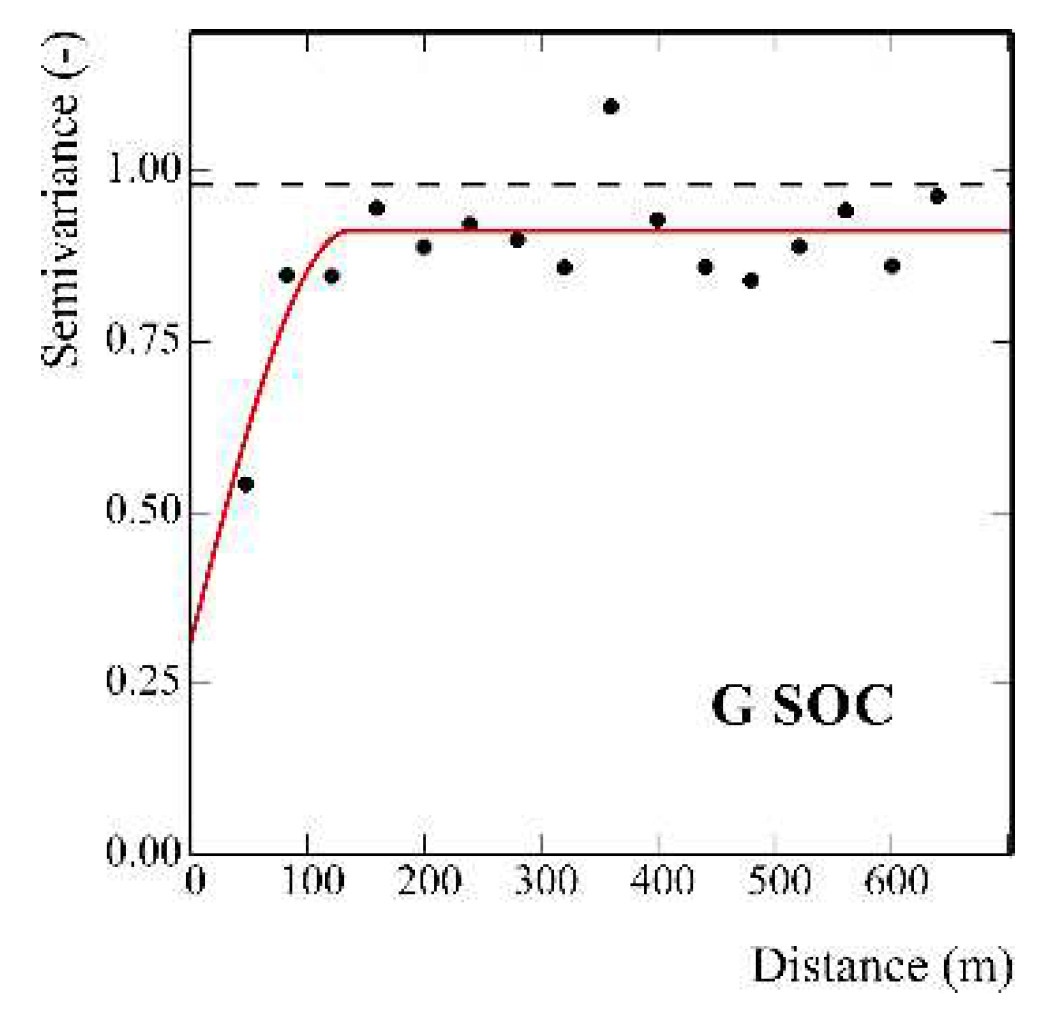
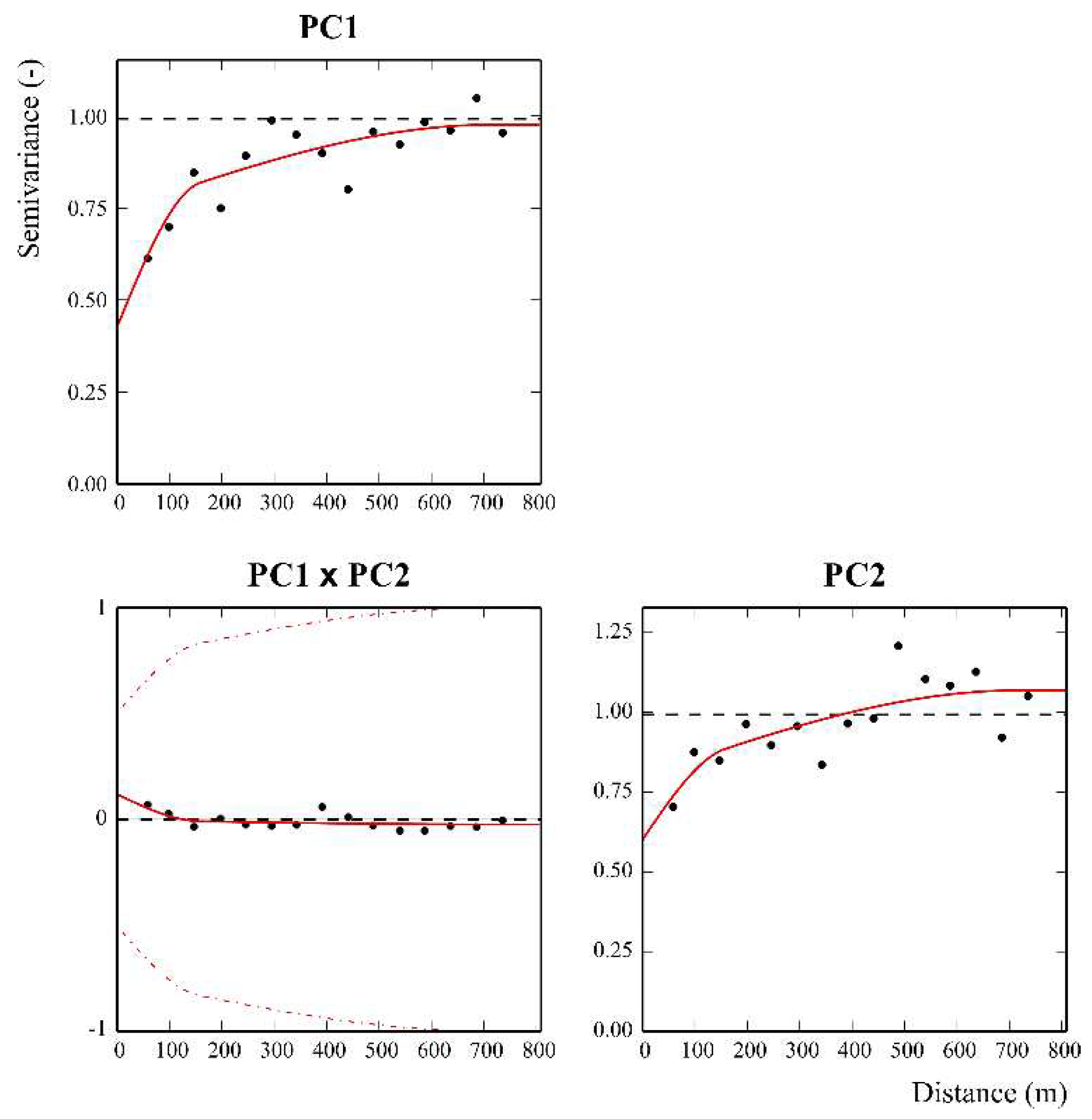
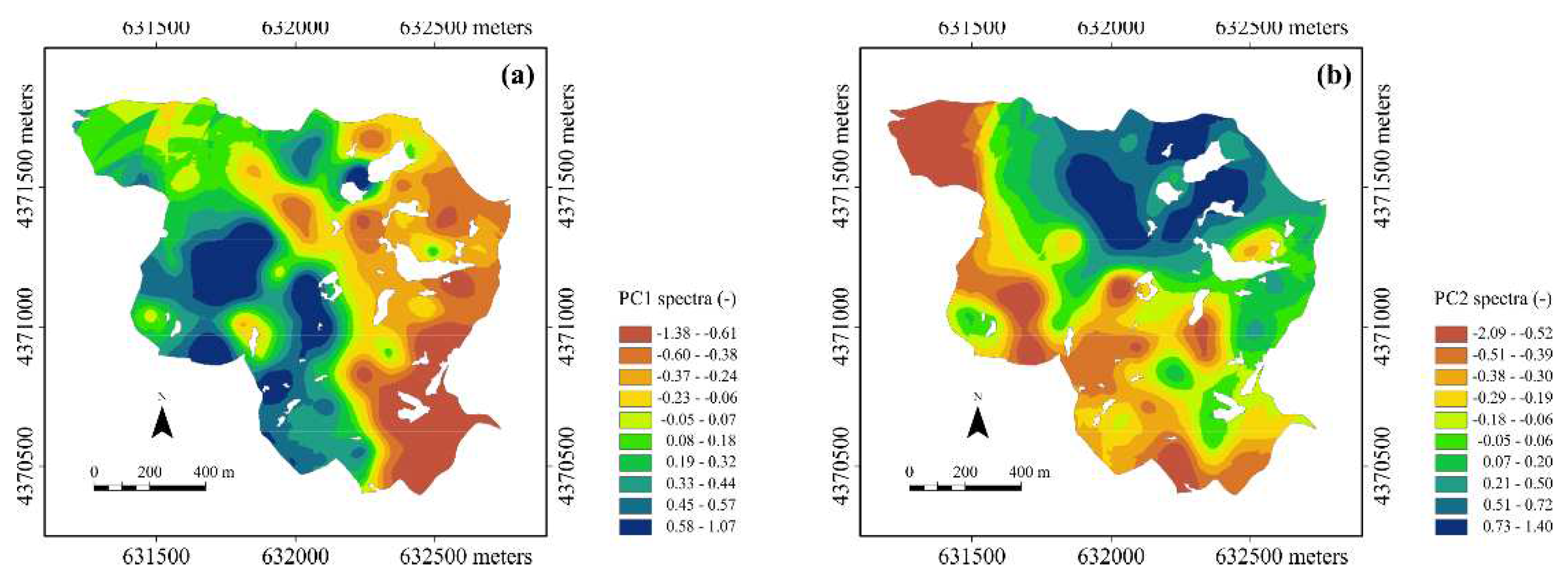
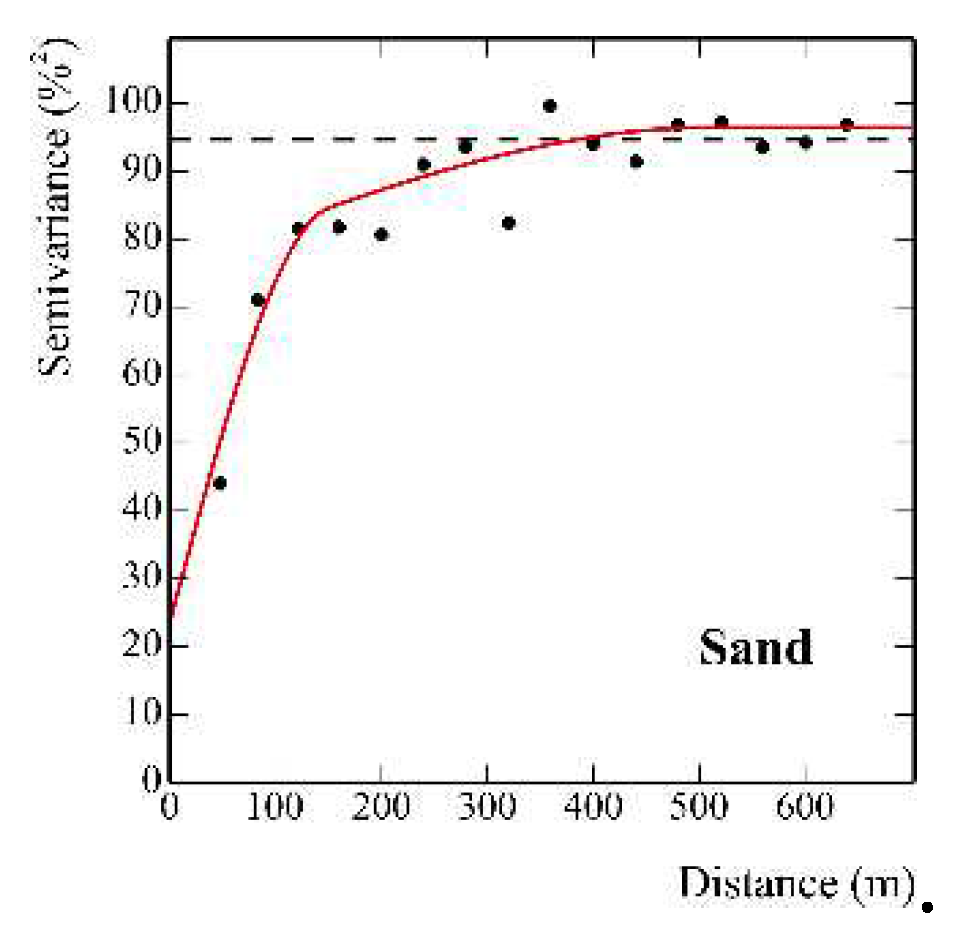
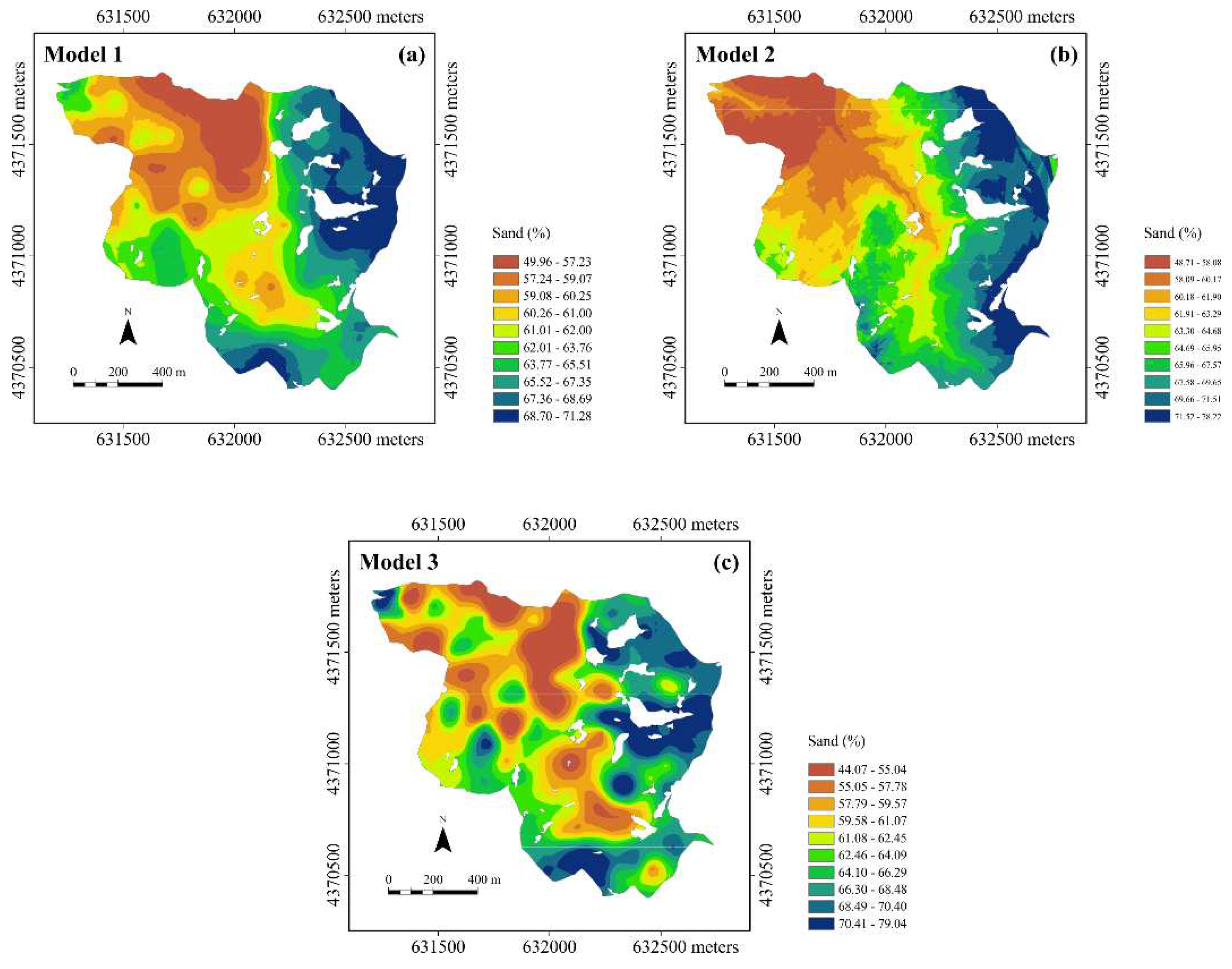
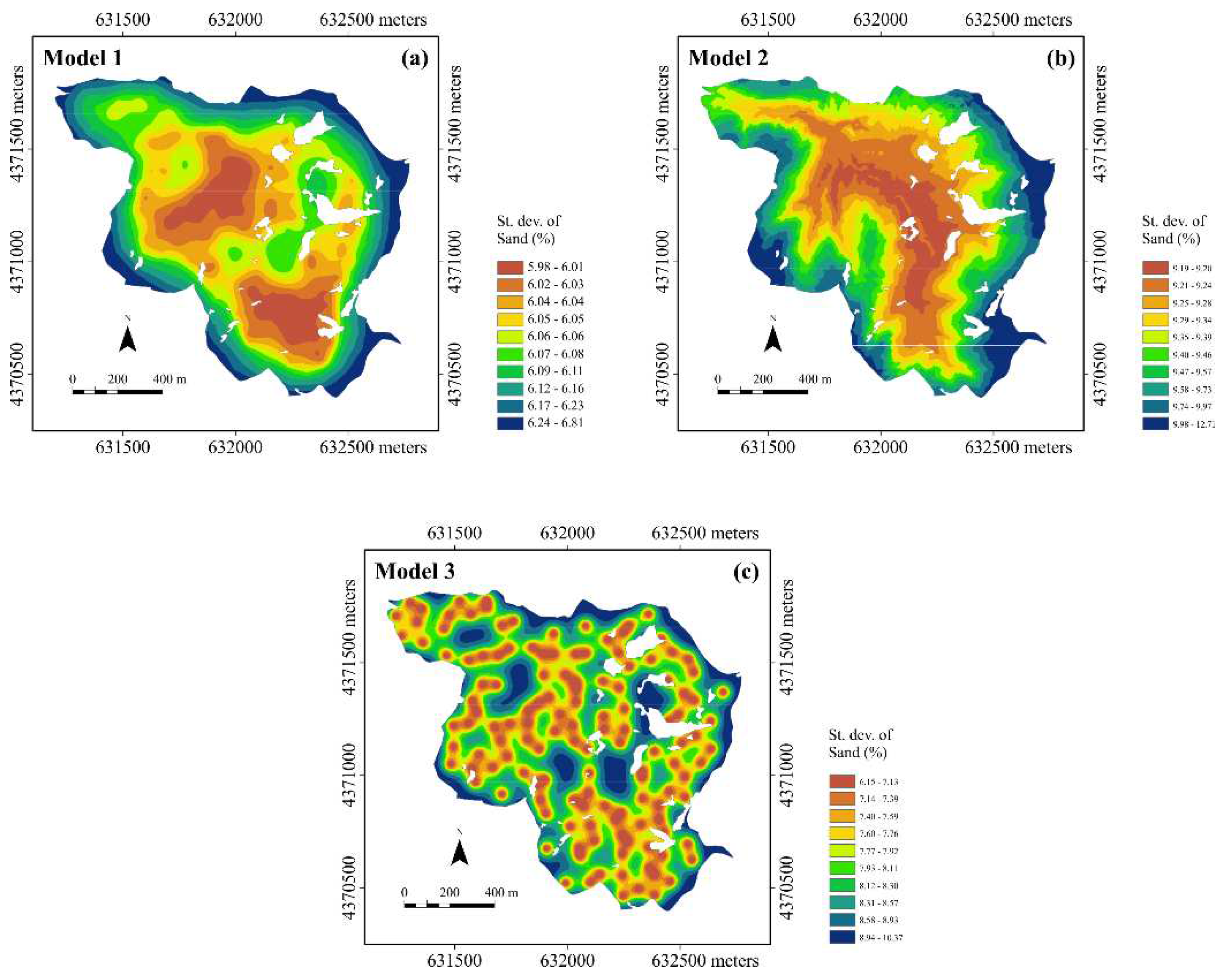
| Statistics | Sand (%) | Silt (%) | Clay (%) | SOC (%) |
|---|---|---|---|---|
| Minimum | 39.00 | 1.00 | 7.00 | 0.67 |
| Median | 63.00 | 22.00 | 15.00 | 2.38 |
| Mean | 62.63 | 21.34 | 16.03 | 2.66 |
| Maximum | 86.00 | 40.00 | 29.00 | 11.02 |
| Stand. Dev. | 9.73 | 6.72 | 5.04 | 1.30 |
| Skewness | -0.26 | 0.00 | 0.72 | 2.69 |
| Kurtosis | 2.86 | 3.01 | 3.11 | 15.58 |
| PC | Eigenvalue | Difference | Explained variance (%) | Cumulative explained variance (%) |
|---|---|---|---|---|
| 1 | 186.61 | 166.34 | 85.21 | 85.21 |
| 2 | 20.27 | 15.89 | 9.26 | 94.47 |
| 3 | 4.38 | 0.81 | 2.00 | 96.47 |
| 4 | 3.57 | 2.05 | 1.63 | 98.10 |
| 5 | 1.52 | 0.40 | 0.69 | 98.79 |
| 6 | 1.12 | 0.61 | 0.51 | 99.31 |
| Statistics | Elevation (m) |
Slope (°) |
Aspect (-) |
LS (-) |
SPI (-) |
TRI (-) |
TWI (-) |
Curvature (-) |
|---|---|---|---|---|---|---|---|---|
| Minimum | 1020.53 | 0.00 | -1.00 | 0.00 | 0.00 | 0.00 | 0.00 | -84.37 |
| Median | 1168.26 | 22.45 | 245.52 | 4.60 | 0.01 | 0.28 | 5.90 | 0.16 |
| Mean | 1171.02 | 23.40 | 213.27 | 5.05 | 0.23 | 0.31 | 5.98 | -0.02 |
| Maximum | 1340.83 | 72.86 | 360.00 | 112.63 | 1131.30 | 7.23 | 24.03 | 89.76 |
| Stand. Dev. | 65.79 | 11.44 | 104.17 | 3.36 | 5.74 | 0.19 | 1.65 | 4.47 |
| Skewness | 0.18 | 0.45 | -0.60 | 2.23 | 65.10 | 1.49 | 1.74 | -1.61 |
| Kurtosis | 2.27 | 2.90 | 2.04 | 24.17 | 6394.88 | 8.71 | 12.44 | 40.59 |
| Variables | Sand | Clay | SOC | PC1 | PC2 | Elevation | Slope | Aspect | LS | SPI | TRI | TWI | Curvature |
|---|---|---|---|---|---|---|---|---|---|---|---|---|---|
| Sand | 1 | ||||||||||||
| Clay | -0.76 | 1 | |||||||||||
| SOC | -0.08 | 0.02 | 1 | ||||||||||
| PC1 | -0.05 | 0.07 | -0.59 | 1 | |||||||||
| PC2 | -0.19 | 0.28 | -0.13 | -0.04 | 1 | ||||||||
| Elevation | 0.42 | -0.37 | 0.26 | -0.36 | -0.18 | 1 | |||||||
| Slope | -0.17 | 0.08 | 0.10 | -0.19 | 0.03 | -0.17 | 1 | ||||||
| Aspect | 0.18 | -0.10 | -0.01 | -0.06 | -0.04 | 0.20 | 0.05 | 1 | |||||
| LS | -0.15 | 0.05 | 0.00 | -0.18 | -0.03 | -0.14 | 0.85 | 0.04 | 1 | ||||
| SPI | -0.04 | 0.06 | -0.06 | 0.07 | -0.09 | -0.06 | -0.13 | -0.16 | 0.04 | 1 | |||
| TRI | -0.19 | 0.09 | 0.10 | -0.16 | 0.14 | -0.23 | 0.89 | 0.01 | 0.75 | -0.08 | 1 | ||
| TWI | -0.02 | 0.02 | -0.21 | 0.11 | -0.17 | 0.11 | -0.48 | -0.13 | -0.08 | 0.60 | -0.43 | 1 | |
| Curvature | -0.08 | 0.21 | 0.08 | -0.05 | 0.30 | 0.02 | -0.06 | 0.07 | -0.33 | -0.25 | -0.07 | -0.37 | 1 |
| (a) Identification of the order k | |||||||||||
|---|---|---|---|---|---|---|---|---|---|---|---|
| Mean Error | Mean Squared Error | Mean Rank | |||||||||
| Trial | Ring1 | Ring2 | Total | Ring1 | Ring2 | Total | Ring1 | Ring2 | Total | ||
| T1: 1 f1 | 0.260 | -0.645 | -0.197 | 44.020 | 49.220 | 46.640 | 7.043 | 6.924 | 6.983 | ||
| T7: 1 f1 f2 | 0.256 | -0.654 | -0.203 | 47.210 | 51.990 | 49.620 | 7.137 | 7.127 | 7.132 | ||
| T9: 1 f1 f2 f3 | 0.529 | -0.676 | -0.079 | 55.440 | 58.050 | 56.760 | 7.933 | 7.574 | 7.752 | ||
| T11: 1 f1 f2 f3 f4 | 0.576 | -0.601 | -0.018 | 61.680 | 63.080 | 62.380 | 8.309 | 8.052 | 8.179 | ||
| T12: 1 f1 f2 f3 f4 f5 | 0.382 | -0.632 | -0.129 | 64.530 | 69.020 | 66.790 | 8.359 | 8.054 | 8.205 | ||
| T2: 1 x y f1 | 0.600 | -1.021 | -0.217 | 48.780 | 65.710 | 57.320 | 7.301 | 8.265 | 7.787 | ||
| T8: 1 x y f1 f2 | 0.745 | -0.934 | -0.102 | 52.060 | 67.750 | 59.970 | 7.568 | 8.392 | 7.983 | ||
| T10: 1 x y f1 f2 f3 | 0.770 | -0.889 | -0.067 | 64.920 | 74.870 | 69.940 | 8.418 | 8.571 | 8.495 | ||
| T13: 1 f1 f2 f3 f4 f5 f6 | 0.734 | -1.036 | -0.158 | 77.280 | 80.660 | 78.990 | 8.967 | 8.754 | 8.860 | ||
| T14: 1 f1 f2 f3 f4 f5 f6 f7 | 0.884 | -0.888 | -0.009 | 86.140 | 96.730 | 91.480 | 9.466 | 9.244 | 9.354 | ||
| T15: 1 f1 f2 f3 f4 f5 f6 f7 f8 | 0.748 | -0.871 | -0.068 | 102.200 | 103.600 | 102.900 | 9.917 | 9.576 | 9.745 | ||
| T16: 1 f1 f2 f3 f4 f5 f6 f7 f8 f9 | 1.008 | -0.783 | 0.105 | 136.400 | 121.700 | 129.000 | 10.328 | 9.663 | 9.993 | ||
| T3: 1 f2 | 0.769 | -1.257 | -0.253 | 108.500 | 115.700 | 112.100 | 10.104 | 10.137 | 10.121 | ||
| T17: 1 f1 f2 f3 f4 f5 f6 f7 f8 f9 f10 | 1.588 | -0.874 | 0.347 | 204.800 | 163.000 | 183.700 | 11.029 | 10.188 | 10.605 | ||
| T5: 1 f3 | 1.118 | -0.735 | 0.184 | 112.900 | 119.100 | 116.000 | 10.297 | 10.476 | 10.387 | ||
| T4: 1 x y f2 | 1.408 | -1.137 | 0.125 | 116.400 | 163.900 | 140.300 | 10.510 | 10.922 | 10.717 | ||
| T6: 1 x y f3 | 1.518 | -0.531 | 0.485 | 117.900 | 158.400 | 138.300 | 10.316 | 11.080 | 10.701 | ||
| Count of measures: Ring1=1260; Ring2=1281; Total=2541 Average Neighborhood Radius: 386.57 m | |||||||||||
| (b) Covariance Identification S1 = Nugget effect; S2 = Order 1 Generalized Covariance (G.C.), Scale = 200 m | |||||||||||
| Explained/Theorical Variance Ratios | Generalized covariance | ||||||||||
| Mean square error (Q) | Ring1 | Ring2 | Rings | Jackknife test | S1 | S2 | |||||
| 0.701 | 0.959 | 1.007 | 0.984 | 0.985 | 32.380 | 5.021 | |||||
| 0.703 | 0.923 | 1.040 | 0.983 | 0.983 | 41.350 | 0.000 | |||||
| 0.717 | 1.026 | 0.831 | 0.910 | 0.894 | 0.000 | 25.150 | |||||
| (a) Identification of the order k | |||||||||||
|---|---|---|---|---|---|---|---|---|---|---|---|
| Mean Error | Mean Squared Error | Mean Rank | |||||||||
| Trial | Ring1 | Ring2 | Total | Ring1 | Ring2 | Total | Ring1 | Ring2 | Total | ||
| T1: 1 f1 | 0.525 | -0.188 | 0.165 | 89.660 | 100.500 | 95.150 | 89.660 | 100.500 | 95.150 | ||
| T2: 1 f1 f2 | 0.873 | 0.137 | 0.501 | 109.100 | 113.500 | 111.300 | 109.100 | 113.500 | 111.300 | ||
| T3: 1 f1 f2 f3 | 0.791 | 0.008 | 0.395 | 116.000 | 115.900 | 116.000 | 116.000 | 115.900 | 116.000 | ||
| T4: 1 f1 f2 f3 f4 | 0.710 | -0.011 | 0.345 | 163.300 | 142.300 | 152.700 | 163.300 | 142.300 | 152.700 | ||
| T5: 1 f1 f2 f3 f4 f5 | 0.749 | 0.080 | 0.410 | 155.400 | 141.700 | 148.500 | 155.400 | 141.700 | 148.500 | ||
| T6: 1 f1 f2 f3 f4 f5 f6 | 0.770 | 0.030 | 0.396 | 132.700 | 126.800 | 129.700 | 132.700 | 126.800 | 129.700 | ||
| T7: 1 f1 f2 f3 f4 f5 f6 f7 | 0.421 | 0.173 | 0.295 | 176.500 | 163.200 | 169.800 | 176.500 | 163.200 | 169.800 | ||
| T8: 1 f1 f2 f3 f4 f5 f6 f7 f8 | 0.179 | 0.080 | 0.129 | 204.400 | 186.800 | 195.500 | 204.400 | 186.800 | 195.500 | ||
| Count of measures: Ring1=3271; Ring2=3343; Total=6614 Average Neighborhood Radius: 493.06 m | |||||||||||
| (b) Covariance Identification S1 = Nugget effect; S2 = Order 1 Generalized Covariance (G.C.), Scale = 200 m; S3 = Spline G.C., Scale = 200 m; S4 = Order 3 G.C., Scale = 200 m | |||||||||||
| Explained/Theorical Variance Ratios | Generalized covariance | ||||||||||
| Mean square error (Q) | Ring1 | Ring2 | Rings | Jackknife test | S1 | S2 | S3 | S4 | |||
| 0.629 | 0.989 | 1.014 | 1.002 | 1.003 | 82.470 | 0.826 | 0.000 | 0.000 | |||
| 0.629 | 0.987 | 1.016 | 1.002 | 1.003 | 84.120 | 0.000 | 0.000 | 0.000 | |||
| 0.677 | 0.956 | 0.821 | 0.879 | 0.870 | 0.000 | 47.980 | 0.000 | 0.000 | |||
| Model | Mean error | RMSSE | r | ρ |
|---|---|---|---|---|
| 1 | -0.0215 | 0.97 | 0.78 | 0.02 |
| 2 | 0.0252 | 0.90 | 0.38 | 0.02 |
| 3 | -0.1398 | 1.13 | 0.35 | 0.16 |
Disclaimer/Publisher’s Note: The statements, opinions and data contained in all publications are solely those of the individual author(s) and contributor(s) and not of MDPI and/or the editor(s). MDPI and/or the editor(s) disclaim responsibility for any injury to people or property resulting from any ideas, methods, instructions or products referred to in the content. |
© 2023 by the authors. Licensee MDPI, Basel, Switzerland. This article is an open access article distributed under the terms and conditions of the Creative Commons Attribution (CC BY) license (http://creativecommons.org/licenses/by/4.0/).





